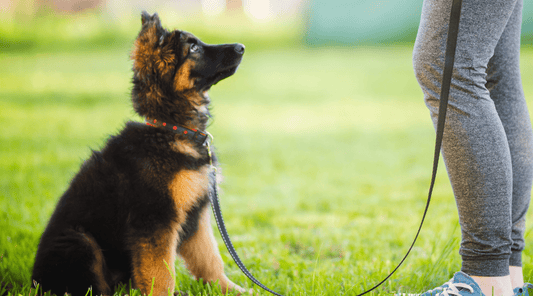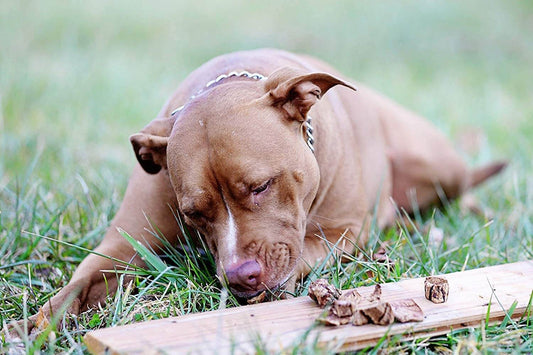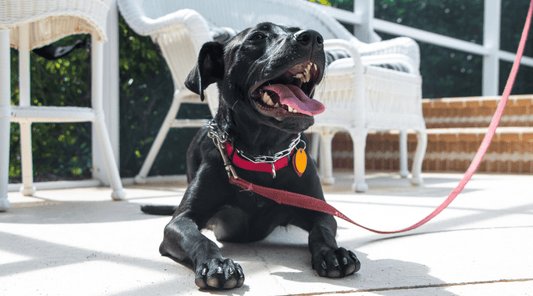
How to Stop Your Dog from Barking at Strangers
Dawn Miller Feb 06, 20255 Minute ReadWith 3 dogs in my home, you might think it gets reasonably chaotic—with a symphony of discordant alert barks when a jogger passes the house. But the truth is that you can learn how to stop your dog from barking at strangers and stealing your peace.
Last Saturday, I heard a familiar commotion while walking Pixie through our neighborhood. My neighbor, Greg, was out in the yard with his chihuahua, Ren, who was developing a reputation as the "town crier" when joggers ran past.
As if on cue, Ren started up as we approached the home, clearly on the sidewalk and not in Ren's yard.
"He's a sweetheart," Greg called out over the barking, "but I can’t seem to stop him from doing this every time someone new shows up!"
As Pixie and Ren exchanged sniff greetings so they wouldn't be strangers anymore, we chatted about why dogs bark at strangers and how training a dog not to bark works.
Why Do Dogs Bark at Strangers?
Unlike cats, who meow only at humans, dogs bark to communicate with each other and their families. They use very distinct barks to:
- Alert others of a possible intruder
- Express anxiety or fear that something isn't right
- Exhibit territorial behavior
- Get attention when they're feeling bored or left out
Ren was barking partly because he was territorial, as any good guard dog should be. But he was a nervous little guy in what he seemed to see as a big, bad world.
Greg was surprised to learn you don't have to live with the ear-shattering barking. He saw it as par for the course when you have a dog. He was even more shocked when I showed him how to stop his dog from barking at strangers.
One of the keys to training dogs not to bark is learning how to reduce a dog's anxiety. If they're not in a heightened state of alert, they won't feel threatened by every little noise.
How to Stop Your Dog from Barking at Strangers
Step 1: Teach a Reliable “Quiet” Command
One of the simplest ways to stop the barking is with a command word like "quiet". In writing, this probably sounds like "shut up". But you're going to say it in the cheeriest way possible. That's what dogs respond well to. So, maybe something like "Ren, Quiiii-et".
As soon as your dog stops barking, reward them with a healthy dog treat. Calming methods for dogs like this reinforce desired behavior. They communicate what you want in a way dogs understand.
They will keep barking because they don't know what "quiet" means yet. So, wait until they stop. Then, say "quiet" and reward them with praise and a treat immediately.
Repeat and reinforce quietness. Practice this consistently so your dog associates "quiet" with stopping barking and getting a treat.
Step 2: Desensitize Your Dog to Strangers
He could invite a "stranger" over, like me, to practice not barking at strangers.
We would start at a distance. Ren notices me but doesn't bark. I then approach slowly. Greg would say "quiet" command and reward Ren for staying calm.
I walked closer, and we repeated the process, with Greg positively reinforcing "not barking".
Step 3: Broaden Your Pup's Social Network
We established that your dog may bark out of anxiety, especially if they don't know many people. So, it's time to fix that. I found out Greg was afraid to take Ren to the dog park to meet others because he's such a small pup.
I could understand his worry. I explained that dog parents at our local dog park understand the value of training a dog with positive reinforcement. So they have reasonable control over their dogs.
I also shared the less crowded hours (weekday work hours and right about dusk on weekends). This would allow Greg and Ren to meet a couple of people and dogs at a time—without feeling overwhelmed.
Step 4: Redirect Their Focus with a Puzzle Toy
When dogs feel engaged in a mentally stimulating activity, they forget to bark. So, if a group of people are outside chatting or there's a party across the street agitating your pup, consider giving them something to do.
I love beef marrow dog bones for this purpose. Chewing is a very soothing activity for dogs. So, it relieves stress.
Marrow bones, in particular, are like engaging dog puzzle toys, too. Dogs gnaw, lick, and flip the bone around, trying to get the bone marrow out.
The bone marrow is buttery and slightly sweet. So, it's rewarding. But it's also incredibly nutritious with omega 3, glucosamine, collagen, and many vitamins and minerals.
Step 5: Redirect with Training
Another option would be to take this time for a training session. Teach them a new command. Or practice what they already know.
I told Greg that this kind of training both keeps Ren's attention in the moment and tests his ability to focus on Greg amid distractions. It also improves a dog's sense of well-being so they feel less anxious and bark less.
With this training, he could keep Ren safe from harm, no matter where they were. That message hit home for Greg.
Step 6: Create a Safe Space
Calming methods for dogs like this really work. Designate a safe place in your home. You will direct them to this spot when they start to get agitated. And they may learn to go to this spot independently when anxious or scared.
A crate works well here. When you introduce the crate correctly, it becomes their wolf's den—a place of safety and comfort. You can put a comfy blanket in there and give them a dog bone to chew on to really make the space feel like a home inside your home.
I share how to crate train in this article.
If you don't want to go the crate route, my lab mix Bruno loves his rug.
Step 7: Establish Regular Chew Sessions
Dogs who feel content and safe bark less. So, learning how to reduce a dog's anxiety works wonders.
Chewing on dog bones is an instinctual activity for dogs. It feeds a primal need, and because of that, it's relaxing. That stress relief can last for days—making a dog easier to train and live with.
I alternate single-ingredient beef trachea chews with dog bones to give my dogs some variety. I call trachea dog treats a dog's natural toothbrush. The ridges help dogs control plaque, gingivitis, and bad breath.
Is helping a dog keep a cleaner mouth also how to reduce a dog's anxiety? Maybe. I know I feel a bit cranky when I haven't brushed my teeth.
Step 8: Establish a Routine
Dogs thrive in a predictable environment, so this should certainly be among the calming methods for dogs to try. To whatever extent, keep consistent feeding, walking, training, and dog bone gnawing times.
Train your dog to follow commands so they feel safe and confident. Teach them games you can play together to strengthen your bond. And most importantly, keep high-value dog training treats on hand to reward them for the behaviors you want to see more of.
Training a dog is easier than you might think. Learn how to train a dog like a boss with this Free 7-Day Dog Training Challenge.
Available On:





